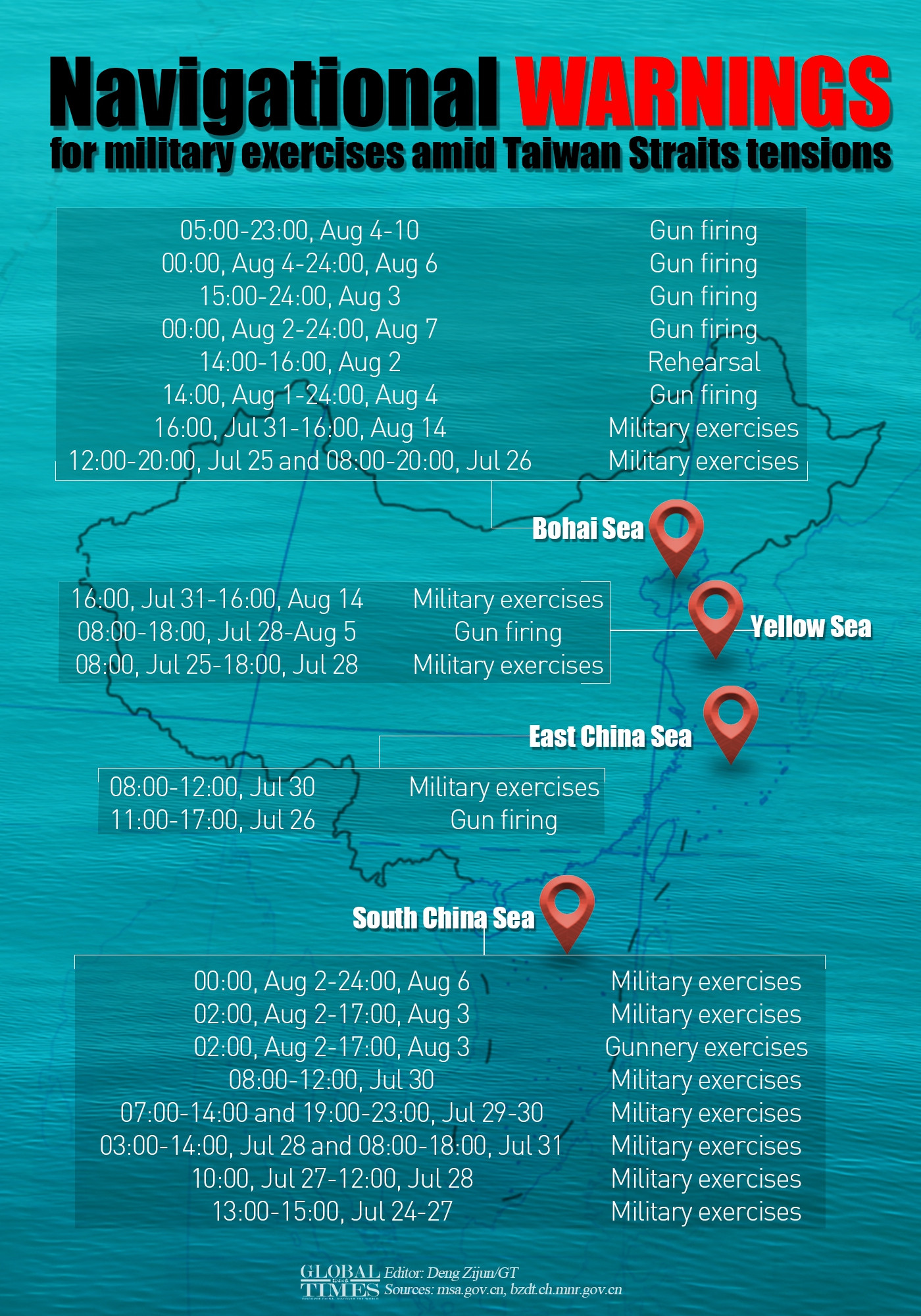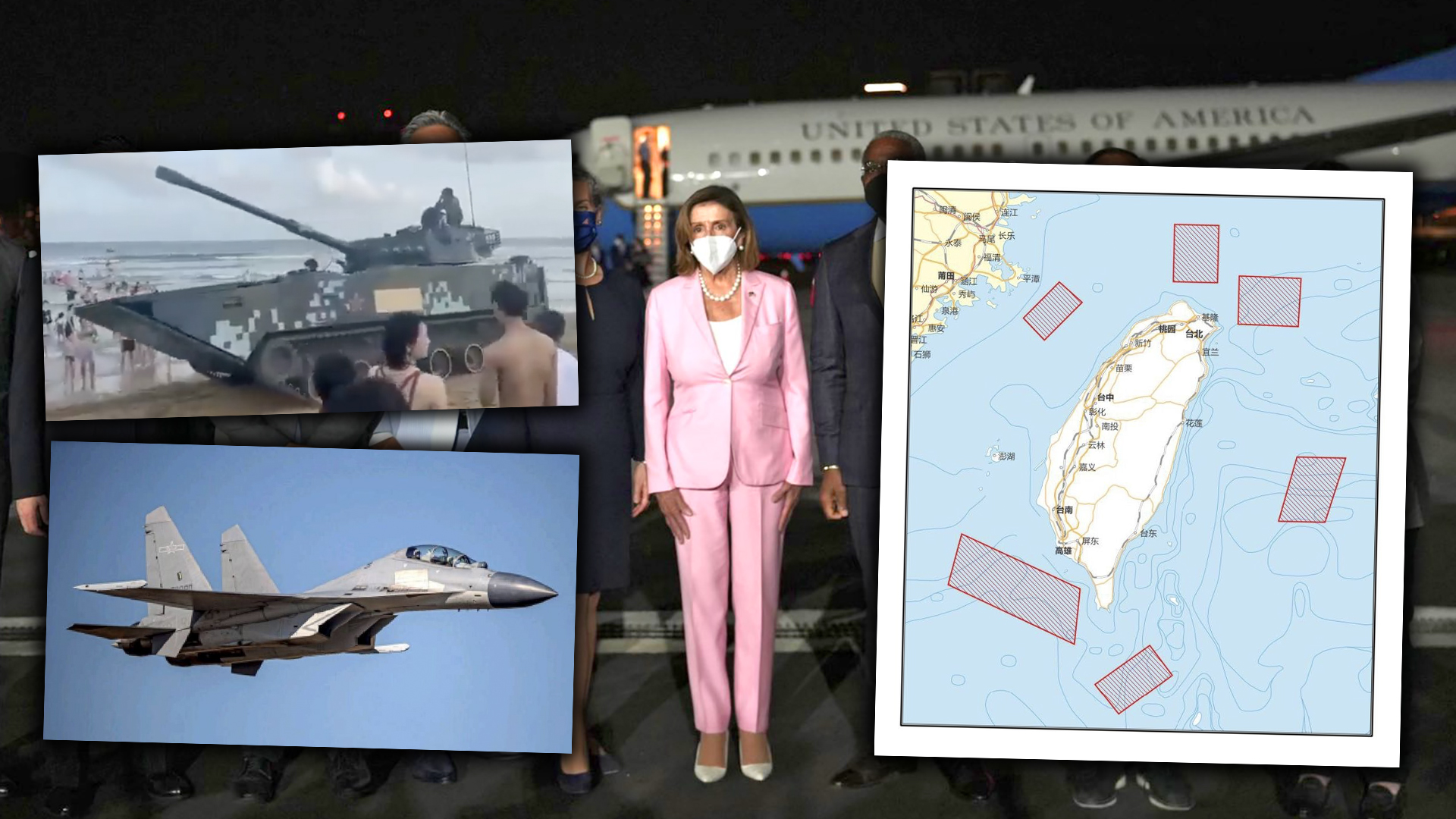As had been increasingly expected for days now, Speaker of the House Nancy Pelosi has arrived in Taiwan along with a Congressional delegation as part of a scheduled trip through Asia. Despite earlier concerns, China’s People’s Liberation Army does not appear to have tried to directly intervene to block Pelosi’s flight. However, Chinese authorities have now announced plans for a series of highly provocative “targeted military operations,” which state media outlets say will be ostensible exercises involving the live-firing of missiles and other weapons in six different areas around the self-governing island.
A Boeing C-40C with the callsign SPAR19, which was subsequently confirmed as the aircraft with Pelosi on board, touched down earlier this evening at Taipei Songshan Airport, which is situated at the northern end of the island. Pelosi was seen disembarking the special air mission aircraft, a militarized Boeing 737-series airliner that’s commonly used for these kinds of missions.
This is the first time a serving Speaker of the House has visited the island — which Beijing claims as part of its sovereign territory — since Newt Gingrich made the trip in 1997. In the United States, the Speaker of the House is the third most senior government official, and would take over as chief executive should the President and Vice President be fully unable to carry out their duties for any reason.
“Our delegation’s visit to Taiwan honors America’s unwavering commitment to supporting Taiwan’s vibrant Democracy,” Pelosi said in a statement issued after she landed on the island. “Our discussions with Taiwan leadership reaffirm our support for our partner & promote our shared interests, including advancing a free & open Indo-Pacific region.”
Pelosi also denied that her visit in any way contradicts or changes U.S. policy with regard to Taiwan. While the U.S. government does not formally recognize the Taiwanese government, it does reserve the right to engage with authorities on the island on diplomatic, military, and other matters, until such time as its status is officially resolved.
The Chinese Foreign Ministry has decried Pelosi’s visit as a “major political provocation” and said that “those who play with fire will perish by it,” in an official statement. This rhetoric very much reflects earlier threats from the Chinese government warning the Speaker against traveling to Taiwan.
Chinese officials also summoned U.S. Ambassador Nicholas Burns to make a formal protest.
To get to Taiwan in the first place, Pelosi’s flight notably set out on a route that took it well away from the hotly contested South China Sea, perhaps in view of the already high tensions between the United States and China in recent days as a result of the expected visit. There had been previous reports suggesting particular activity within China’s Southern Theater Command, apparently in the expectation that Pelosi would pass through its area of responsibility en route to Taiwan.
In the run-up to Pelosi’s tentative Taiwan visit, there had also been fears that Chinese warplanes might intercept her plane and attempt to drive it out of the area. Other provocative encounters between Chinese fighters and U.S., Australian, and Canadian military aircraft in recent years only underscored these concerns. Those worries had reportedly led the White House and the U.S. military to initially push the Speaker to cancel the Taiwan trip altogether.
It is unclear at this stage if Pelosi’s plane was escorted in the end by friendly aircraft at any point in its flight. There had been speculation that Taiwanese F-16V fighters might accompany the jet into Taipei. Another possibility is that an escort was provided by eight U.S. Air Force F-15C/D fighter jets that reportedly left Kadena Air Base on the Japanese island of Okinawa, along with five aerial refueling tankers, earlier today.
The Air Force F-15C/Ds may simply have been airborne on alert in case any number of contingencies emerged. Online flight tracking data indicated that a variety of other U.S. military aircraft have also been tracked today operating in the vicinity of Taiwan. These have reportedly included an E-3 Airborne Warning and Control System (AWACS) radar plane, an RC-135V Rivet Joint spy plane, an HC-130J Combat King II combat search and rescue aircraft, all from the U.S. Air Force, as well as a U.S. Navy P-8A Poseidon maritime patrol plane and EP-3E Aries II intelligence, surveillance, and reconnaissance aircraft.
The HC-130J is notable as it would be considered a critical asset for coordinating and executing a search and rescue attempt, even under hostile conditions, should something have happened to the flight.
In addition, a major U.S. Navy force is understood to be operating in the Western Pacific somewhere between the northern end of the Philippines and the southern end of Taiwan. This grouping includes the supercarrier USS Ronald Reagan (CVN-76) and the amphibious assault ships USS America and USS Tripoli, along with their respective air wings and escorts.
“We never talk about security details for unconfirmed or confirmed travel,” a Pentagon spokesperson told The War Zone in a statement in response to questions about what support the U.S. military is providing for Pelosi’s Taiwan visit. “We of course take all appropriate measures to ensure the safety of Members of Congress wherever and whenever they choose to travel.”
Regardless, in the end, there appear to be no indications that the People’s Liberation Army (PLA) attempted to prevent Pelosi’s flight from reaching Taipei. However, Taiwanese authorities say that 21 Chinese military aircraft subsequently entered the southern end of the island’s Air Defense Identification Zone (ADIZ). This force included eight J-11 and 10 J-16 fighter jets, both derived from the Soviet Su-27 Flanker design, as well as a KJ-500 airborne early warning and control plane, a Y-9 electronic warfare aircraft, and a Y-8 electronic intelligence platform, according to the Taiwanese Ministry of National Defense. While the bulk of the ADIZ consists of international airspace, the regime in Beijing has increasingly used flights like this to pressure its counterparts in Taipei and otherwise express its displeasure with events concerning the island in the past few years.
Taiwanese authorities also rejected earlier Chinese state media reports that some of the PLA’s Russian-made Su-35 Flanker-E fighters had flown into the Taiwan Strait, and had potentially come close to or even crossed the so-called “median line” that serves as a de facto boundary with the mainland.
This ADIZ intrusion is just one part of the Chinese response. Easily more worrisome are plans China’s Ministry of Defense has announced for what a machine translation of the official statement calls “targeted military operations” in six distinct zones around Taiwan.
“The Chinese People’s Liberation Army is on high alert and will launch a series of targeted military operations to counter it, resolutely defend national sovereignty and territorial integrity, and resolutely thwart external interference and ‘Taiwan independence’ separatist attempts,” the statement says, according to the translation.
State media outlets have described these planned activities as live-fire exercises, but they could well reflect existing PLA concepts of operation for an actual intervention against Taiwan. Purported drills are precisely the kind of thing one might expect to see occur repeatedly in the lead up to a real invasion. Russia, for instance, conducted a number of large-scale exercises in areas near Ukraine prior to invading that country, and had also claimed its buildup for that operation was another series of drills.
Experts and observers have noted that some of the areas in question overlap with places where Chinese forces carried out exercises in 1996 as part of the Third Taiwan Strait Crisis, a seminal moment in post-Cold War U.S.-Chinese relations.
However, the newly announced zones are far more provocative and include areas that are within what are considered to be Taiwan’s territorial waters and its internal waters.
Video footage and pictures purportedly showing Chinese forces moving toward the country’s eastern and southern coastal areas had begun to emerge online, as well. This includes clips showing amphibious armored vehicles on a beach in the southern city of Xiamen, as well as what appear to be DF-16 road-mobile short-range ballistic missiles on train cars in Fujian province, which sits right on the Taiwan Strait.
There have been other suggestions that there may be significant Chinese military movements planned, as well. Today there were reports of disruption to domestic air traffic in Fujian province, which overlooks the Taiwan Strait. This may indicate that large-scale military aircraft movements are imminent, especially as at least some of the airports in the region affected have a dual military-civilian function.
On top of that, in the PLA’s Southern Theater Command, which is responsible for the South China Sea and would also have a wartime role to play in any Taiwan-related contingency, military units have been put on a high level of alert, according to the Financial Times, citing unnamed military officials in two neighboring countries.
Snap exercises are also now expected to take place in the East Sea, the Yellow Sea, and the Bohai Sea further to the north of Taiwan. There had already been reports of an uptick in PLA Navy activity in various locations, including more regular patrols off Taiwan’s east coast in the last few days, including the departure of both of China’s current operational aircraft carriers from their respective homeports.

Yesterday, John Kirby, coordinator for strategic communications for the National Security Council, had said that U.S. authorities had observed the Chinese government “positioning itself to potentially take further steps” in response to Pelosi’s potential visit to Taiwan, but did not provide specifics. He did warn that live-fire exercises, as well as ADIZ intrusions or crossing the media, among other things, were possible courses of action authorities in Beijing could take in response to Pelosi’s visit.
The Taiwanese government also said earlier today that it has come under cyber attack. According to the Office of the Taiwanese presidency, its official website was taken down for 20 minutes this evening. While Chinese actions were not mentioned, the office did describe the incident as “an overseas denial of service attack.”
With Pelosi only expected to remain in Taiwan for a day or so, there is still very much the potential for her outgoing flight to be challenged in some way by the PLA. There will simply be the matter of needing to navigate through the newly announced exercise areas to get out of the area at all.
All told, it very much remains to see what the full extent of the fallout from Pelosi’s visit to Taiwan will be, but the actions already being taken by the PLA, together with the extreme rhetoric from Chinese officials, can only be cause for concern. At the same time, the visit stands as an act of U.S. defiance against an increasingly aggressive China that has its sights set squarely on regaining control of Taiwan, one way or another.
Contact the author: thomas@thedrive.com and Joe@thedrive.com
